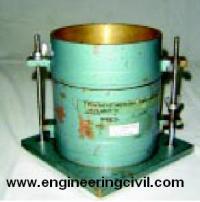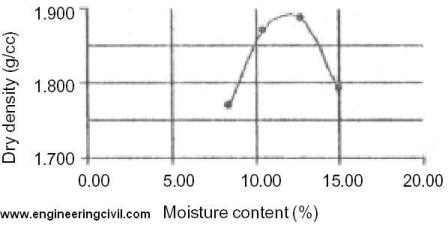This test is done to determine the maximum dry density and the optimum moisture content of soil using heavy compaction as per IS: 2720 (Part 8 ) – 1983.The apparatus used is
i) Cylindrical metal mould – it should be either of 100mm dia. and 1000cc volume or 150mm dia. and 2250cc volume and should conform to IS: 10074 – 1982.
ii) Balances – one of 10kg capacity, sensitive to 1g and the other of 200g capacity, sensitive to 0.01g
iii) Oven – thermostatically controlled with an interior of noncorroding material to maintain temperature between 105 and 110oC
iv) Steel straightedge – 30cm long
v) IS Sieves of sizes – 4.75mm, 19mm and 37.5mm

PREPARATION OF SAMPLE
A representative portion of air-dried soil material, large enough to provide about 6kg of material passing through a 19mm IS Sieve (for soils not susceptible to crushing during compaction) or about 15kg of material passing through a 19mm IS Sieve (for soils susceptible to crushing during compaction), should be taken. This portion should be sieved through a 19mm IS Sieve and the coarse fraction rejected after its proportion of the total sample has been recorded. Aggregations of particles should be broken down so that if the sample was sieved through a 4.75mm IS Sieve, only separated individual particles would be retained.
Procedure To Determine The Maximum Dry Density And The Optimum Moisture Content Of Soil
A) Soil not susceptible to crushing during compaction –
i) A 5kg sample of air-dried soil passing through the 19mm IS Sieve should be taken. The sample should be mixed thoroughly with a suitable amount of water depending on the soil type (for sandy and gravelly soil – 3 to 5% and for cohesive soil – 12 to 16% below the plastic limit). The soil sample should be stored in a sealed container for a minimum period of 16hrs.
ii) The mould of 1000cc capacity with base plate attached, should be weighed to the nearest 1g (W1 ). The mould should be placed on a solid base, such as a concrete floor or plinth and the moist soil should be compacted into the mould, with the extension attached, in five layers of approximately equal mass, each layer being given 25 blows from the 4.9kg rammer dropped from a height of 450mm above the soil. The blows should be distributed uniformly over the surface of each layer. The amount of soil used should be sufficient to fill the mould, leaving not more than about 6mm to be struck off when the extension is removed. The extension should be removed and the compacted soil should be levelled off carefully to the top of the mould by means of the straight edge. The mould and soil should then be weighed to the nearest gram (W2).
iii) The compacted soil specimen should be removed from the mould and placed onto the mixing tray. The water content (w) of a representative sample of the specimen should be determined.
iv) The remaining soil specimen should be broken up, rubbed through 19mm IS Sieve and then mixed with the remaining original sample. Suitable increments of water should be added successively and mixed into the sample, and the above operations i.e. ii) to iv) should be repeated for each increment of water added. The total number of determinations made should be at least five and the moisture contents should be such that the optimum moisture content at which the maximum dry density occurs,
lies within that range.
B) Soil susceptible to crushing during compaction –
Five or more 2.5kg samples of air-dried soil passing through the 19mm IS Sieve, should be taken. The samples should each be mixed thoroughly with different amounts of water and stored in a sealed container as mentioned in Part A)
C) Compaction in large size mould –
For compacting soil containing coarse material upto 37.5mm size, the 2250cc mould should be used. A sample weighing about 30kg and passing through the 37.5mm IS Sieve is used for the test. Soil is compacted in five layers, each layer being given 55 blows of the 4.9kg rammer. The rest of the procedure is same as above.
REPORTING OF RESULTS
Bulk density Y(gamma) in g/cc of each compacted specimen should be
calculated from the equation,
Y(gamma) = (W2-W1)/ V
where, V = volume in cc of the mould.
The dry density Yd in g/cc
Yd = 100Y/(100+w)
The dry densities, Yd obtained in a series of determinations should be plotted against the corresponding moisture contents,w. A smooth curve should be drawn through the resulting points and the position of the maximum on the curve should be determined. A sample graph is shown below:

The dry density in g/cc corresponding to the maximum point on the moisture content/dry density curve should be reported as the maximum dry density to the nearest 0.01. The percentage moisture content corresponding to the maximum dry density on the moisture content/dry density curve should be reported as the optimum moisture content and quoted to the nearest 0.2 for values below 5 percent, to the nearest 0.5 for values from 5 to 10 percent and to the nearest whole number for values exceeding 10 percent.
If you have a query, you can ask a question here.



when sample contain material large than 19mm what can i do , the procter astm D1557 not …..
use the sieve it may be necessary for you
is the a way/calculations of confirming results on site of MDD and MC of a sample that has been tested and compacted? to chech if it met the prescribed type of material and compaction?
yes it helps in the determination of amount of compaction required at the field…..its 97% provided at the field
in this u not describe how to determine the water content
haw mauch MDD for sand
sir, plz give me value of omc-mdd in CI,CH,MI,MH type of soil..
Sir. My question is related from MDD test of soil. What should material dry before MDD test with reason…plz
Material is dry so that it doesn’t contain any moisture in it
why do we have MDD curve?
Compaction of soil up to 95% of maximum dry density equivalent to how much on kgf/cm2
I don’t really get the understanding behind compaction
compaction is to do with volume. When you do a test(in the field) like this you are given a specific criteria regarding the the %of compaction for the soil, so you need determine how the soil your given behaves under compaction with different moisture contents
Compaction is the process of removing voids by whatever method. % compaction on site would the the ratio between densification achieved on site and the maximum dry density achieved in a laboratory under a specific effort. Efforts used in a laboratory vary from country to country (as there are numerous codes of practice) e.g. MOD AASHTO, NRB, PROCTOR, GYRATORY EFFORT etc … The correct terminology on site is ‘relative compaction’ (self explanatory)
How to find out the degree of compaction of crushed sand at field. we have derived Maximum Dry Density and Optimum Moistrue Content of Crushed sand
Sir, is it necessary to conduct MDD compaction test to 95% for structures provided with jet grouted piles?
Sirs if the area were provided with jet grouted piles is it necessary to conduct laboratory compaction??
how we can use rapid moisture meter data to find out % of compaction with reference MDD test
Dear Sirs,
Is there any correlation between MDD and Compaction? I see that the higher the value of the MDD the lower the compaction therefore I would like to understand how I will achieve 100% compaction with MDD of 2++? Note that I am using a Nuclear Gauge to do the Field Compaction Tests?
what should be the range of maximum dry density and the range of optimum moisture content
SIR WHAT IS THE ROCESS OF MAXIUM DRY DENSITY & MOISTURE CONTENT GRAPH ON LAP TOP.EXPLAIN & DETAIL
Is 2720 part 8
How will the soil compaction testing procedure differ if the soil particles susceptible to crushing under the degree of compaction applied during the test?
can we have any limits for OMC for soil